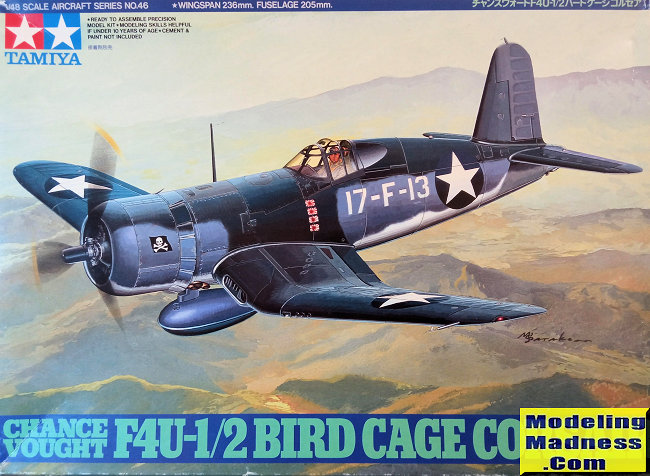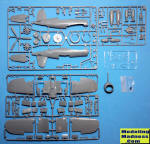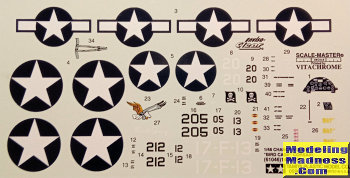
Tamiya 1/48 F4U-1/2 Corsair
| KIT #: | 61046 |
| PRICE: | Around €20 |
| DECALS: | Four options |
| REVIEWER: | Spiros Pendedekas |
| NOTES: |

| HISTORY |
The F4U Corsair is an American fighter which saw service primarily in World War II and the Korean War. Designed and initially manufactured by Chance Vought, the type was soon in great demand, with additional production contracts given to Goodyear, whose Corsairs were designated “FG” and Brewster, designated “F3A”.
Designed and operated as a carrier-based aircraft, and entering service in large numbers with the U.S. Navy in late 1944 and early 1945, it quickly became one of the most capable carrier-based fighter-bombers of the war, achieving an 11:1 kill ratio.
Early problems with carrier landings and logistics led to it being eclipsed as the dominant carrier-based fighter by the nevertheless formidable F6F Hellcat, with the Corsair's early deployment being to land-based squadrons of the U.S. Marine Corps and the U.S. Navy.
Throughout the Korean War and during the French colonial wars in Indochina and Algeria, the type served almost exclusively as a fighter-bomber. In addition to its use by the U.S. and British, it was also used by the Royal New Zealand Air Force, the French Naval Aviation, and other air forces until the 1960s.
From the first prototype delivered to the U.S. Navy in 1940 to the final delivery in 1953 to the French, 12,571 F4U examples were manufactured in 16 separate models. Its 1942–1953 production run was the longest of any U.S. piston-engined fighter.
| THE KIT |
 This
is the initial release of the quarter scale F4U family that Tamiya decided to
treat us with from as early as 1996, the following editions being the -1D, the
non-bird cage -1A (including a motorized version) and another -1D version
including a moto-tug. The specific kit comes in the typical excellent Tamiya top
opening box, featuring a most charming box art depicting Lt.James A.Halford’ s
bird, flying over some land in August 1943.
This
is the initial release of the quarter scale F4U family that Tamiya decided to
treat us with from as early as 1996, the following editions being the -1D, the
non-bird cage -1A (including a motorized version) and another -1D version
including a moto-tug. The specific kit comes in the typical excellent Tamiya top
opening box, featuring a most charming box art depicting Lt.James A.Halford’ s
bird, flying over some land in August 1943.
Upon opening the box, I was greeted with 97 dark gray parts arranged in three
sprues. Molding is very crisp with no flash at all. Panel lines are finely
recessed and seemingly correctly done. A few sink marks were spotted, which
should be easily remedied, as well as some ejector pin marks at visible areas
(like the wheel wells), some more challenging to eliminate than others.
Cockpit is very well appointed, with all main elements well represented and will
be sufficient out of the box for most of us. The instrument panel has nice
molded-on instruments onto where two equally nice decals are to be applied and
snuggle down. A good looking pilot is also provided, should you wish to place
him inside.
The engine is very well represented, with options for opened or closed cowling
flaps, but the prominent cylinders cry for a wiring harness (not too difficult
to be done by the average modeler with some means of thin wire or so). The pair
of exhaust triplets looks good (you may wish to drill the holes out for extra
realism), as do the exhaust tubes aft of the firewall that will be visible if
you select the “open” cowling flaps option. Finally, the one piece prop looks
very well done, which is secured in position by the famous and very handy "polycaps".
The wings can be built folded or unfolded, with the exposed inner frames in the
former case reasonably detailed. The distinctive flaps are provided separately,
adding a lot to the final looks. Regarding the famous starboard inner flap
cutout piece, this was a practice implemented after the war, so, for a war era
machine you should somehow fill it. The starboard mounted radar dome, which is
correct for the -2 version, looks good too.
Positive comments also for the landing gear, which is well detailed and, of
course, asking for brake lines is maybe too much. The wheels have separate
external side covers, making their painting a breeze. Optional external stores
include either a bomb or a drop tank.
Transparencies are wonderfully done, including two styles of canopies (with
bulged or flat front top), depending on the version/plane you are building.
Instructions are provided in the usual, equally wonderful Tamiya pamphlet style
with a brief history of the type and the construction spread in 9 crystal clear
steps, including full color callouts.
 Three
schemes are provided for equally famous birds, one being the box art in Navy
blue and intermediate blue over white, the other two being intermediate blue
over light gray. Colors are given in Tamiya codes and also in generic names.
Decals are superbly printed by Scalemaster and, though dated “1996”, look to be
in usable condition.
Three
schemes are provided for equally famous birds, one being the box art in Navy
blue and intermediate blue over white, the other two being intermediate blue
over light gray. Colors are given in Tamiya codes and also in generic names.
Decals are superbly printed by Scalemaster and, though dated “1996”, look to be
in usable condition.
Instructions want you to first assemble the cockpit, the engine and the central
wing. The cockpit has then to be trapped between the fuselage halves, followed
by attachment of the engine and central wing. Landing gear assembly and
installation is next, followed by assembly of the outer wings.
Attachment of the central wing flaps, the exhausts, the prop and optionally the
drop tank or bomb come afterwards, followed by the transparencies and the
antenna mast (correct for the -1A version only). Final step is the
installation of the outer wings in “folded” or “unfolded” position, ending a
pleasant, uncomplicated build.
| CONCLUSIONS |
Now a classic, this is still a
wonderful kit of the iconic Corsair. Molding is great as are the details
provided, instructions are clear and decals are excellent. Despite the not
exactly low parts count, the build is uncomplex. As can be witnessed at the many
wonderful finished models reviews found at the MM archives, the kit builds
effortlessly and yields a wonderful result, even straight out of the box.
Per its usual (and very welcome) trend, Tamiya periodically reissues this kit at
low prices and with fresh decals, making it a kit worth tackling.
Happy modeling!
Copyright ModelingMadness.com. All rights reserved. No reproduction in part or in whole without express permission.
If you would like your product reviewed fairly and fairly quickly, please contact the editor or see other details in the Note to Contributors.